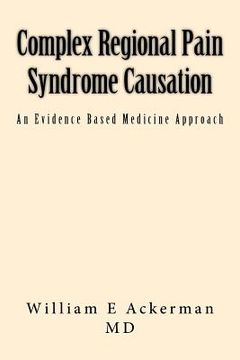Complex Regional Pain Syndrome Causation: An Evidence Based Medicine Approach (en Inglés)
Reseña del libro "Complex Regional Pain Syndrome Causation: An Evidence Based Medicine Approach (en Inglés)"
The Complex regional pain syndrome condition currently known as CRPS was originally described during the American Civil War by Silas Weir Mitchell. Is the Complex Sympathetic Regional Pain Syndrome (CRPS) an inflammatory entity or an autoimmune disease? Because treatments can differ between these two entities it is important to understand what is the pathology of each entity so the proper treatment can be introduced. Epidemiologic studies conclude that the incidence of CRPS is low. The complex regional pain syndrome is an uncommon form of chronic pain that usually affects an arm or a leg. CRPS is a chronic pain condition that mainly affects the arms, legs, hands, and feet, but may involve the entire body. CRPS symptoms often begin after an injury. The main feature of CRPS is continuous, intense pain that is out of proportion to the severity of the injury. The complex regional pain syndrome typically develops after an injury, surgery, stroke or heart attack, but the pain is out of proportion to the severity of the initial injury. CRPS occurs as a result of dysfunction in the central or peripheral nervous systems. It affects women more often than men. There is no cure for CRPS. With CRPS a patient's brain develops maladaptive neuroplasticity. CRPS most likely does not have a single cause; rather, it results from multiple causes that produce similar symptoms. With injury-related CRPS, the syndrome may be caused by a triggering of the immune response. There is no specific diagnostic test for CRPS, but some tests can rule out other conditions. Recent research has shown that some patients respond to treatment with immunoglobulins, and that a majority have IgG serum-autoantibodies directed against, and activating autonomic receptors. CRPS serum-IgG, when transferred to mice elicits abnormal behavior. These results suggest that CRPS is associated with an autoantibody-mediated autoimmune process in some cases. Clinical observations of patients with CRPS associated with patchy osteoporosis suggest that CRPS may have two distinct compo-nents: (1) neuropathic pain that includes severe spontaneous pain or severe persistent mechanical allodynia and (2) prolonged regional inflammation, the early phase of which could be indicated by positive inflammatory symptoms of pain (tenderness), heat, redness, swelling and loss of function and their alleviation with corticosteroids. It is hypothesized that peripheral CRPS pain may be influenced by an inflammatory cause while central neurologic pain may be related to an autoimmune origin. Further research in this area is definitely indicated. It is anticipated that this information presented in this book will provoke discussion, interest and promote further empirical studies on the interactions between central and peripheral inflammatory pathways manifest in CRPS. Concepts of cause and causal inference are largely self-taught from early learning experiences. A model of causation that describes causes in terms of sufficient causes and their component causes illuminates important principles such as multi-causality, the dependence of the strength of component causes on the prevalence of complementary component causes, and interaction between component causes. The determination of CRPS must therefore, be based on sound science. This however, is difficult when one attempts to assign a specific medical diagnosis to a condition that is primarily determined by subjective symptoms and nonspecific physiologic signs and has no valid diagnostic tests to make an accurate diagnosis. It would furthermore, be unreasonable to attribute CRPS causation to a single factor when clearly other risk factors are present. However, thermography and skin biopsy with small nerve fiber analysis may be helpful as well as reliable is determining a diagnosis of CRPS. CRPS biologic and legal causation are addressed in this book. This book should be read by patients, family members, attorneys, insurance adjusters etc.

